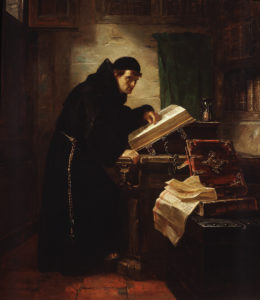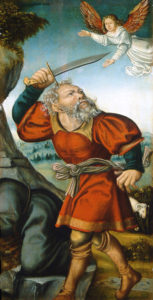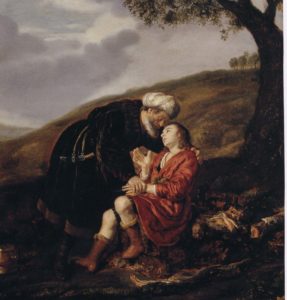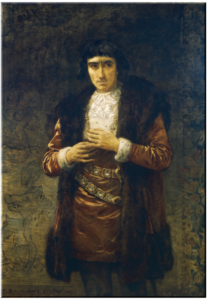Martin Luther Discovering Justification by Faith
Edward Matthew Ward, R. A.
Below the image, click play to listen.
Oil on canvas, Signed and dated: E M Ward, R A, 1868 (lower left)
English, 1816–1879

Edward Ward’s portrait of Martin Luther Discovering Justification by Faith draws on traditional elements of portraiture. Like most scholar portraits, this one places the sitter in his “study” surrounded by precious manuscripts and books on theology.
An enormous Bible is chained to the lectern. Bibles were rare and expensive to construct during the sixteenth century and were usually chained so that they would not be moved or lost. But here the chain is also symbolic. In the context of the reformer’s inner turmoil, the chain represents the inaccessibility of God’s Word—an obstacle that Luther is about to overcome through his discovery. This moment of enlightenment is also foreshadowed by the light streaming in through the open window, a common motif symbolizing heavenly illumination.
In addition, the hourglass as a symbol of time represents not only the brevity of this life (through the falling sand) but also the possibility of resurrection (through reversing the glass).
Like Ward’s beautifully rendered portrait, the following fragment from Luther’s autobiography vividly captures the power of this moment:
Night and day I pondered until I saw the connection between the justice of God and the statement ‘the just shall live by his faith.’ Then I grasped that the justice of God is that righteousness by which, through grace and sheer mercy, God justifies us through faith. Thereupon I felt myself to be reborn and to have gone through open doors into paradise. The whole of Scripture took on new meaning, and whereas before ‘the justice of God’ had filled me with hate, now it became to me inexpressibly sweet in greater love. This passage of Paul became to me the gate of heaven.
Click on the dropdown information below for further insights:
Although opposed to the veneration of images, Martin Luther did not object to using art in worship or in education. According to Luther, images “are neither good nor bad.” They are “unnecessary and we are free to have them or not.” He went on to say that visual art may be of considerable benefit in preaching and teaching the good news (as his artist friends the Cranachs sought to do). However, the leading Swiss reformer Huldrych Zwingli disagreed vehemently with Luther on this issue. Zwingli who preached for twelve years at the famed Grossmünster’s pulpit in Zurich ordered all altar paintings and statues removed from the church. This church, which still stands today, remains “quite bare, entirely stripped of the statues and paintings denounced by Zwingli.”
As the years passed the debate on the use of images in worship and religious education became less strident, though differences remained. For example, unlike Luther’s followers, artists like Jan Victors who embraced Calvin’s ideas refused to paint images of God (including God the Son), opting to focus on Old Testament scenes or New Testament parables.
Abraham’s sacrifice of Isaac was one subject that captured the imagination of those on both sides of the debate. This Old Testament narrative adumbrating Christ’s atoning grace was central to all Protestant theologians, but the prophetic vehicle allowed artists who held views similar to Zwingli or Calvin to avoid violating their conscience in visually rendering God the Son.
The Sacrifice of Isaac by Lucas Cranach, the Elder, a friend and follower of Luther captures the climactic moment of the story.
The reproduction below is by one of Calvin’s followers, Jan Victors. Victor’s rendering of the biblical narrative captures the intimate moment between father and son just before Isaac is bound the altar.


Donnalynn Hess, Director of Education
Published in 2017
Oil on canvas
English, c. 1829-d. 1891

Henry Irving, the foremost actor in England from 1866 to 1902, was the first actor to be knighted for his artistry, which helped raise the social standing of the acting profession. As the premier actor and director of the Royal Lyceum Theatre, Irving produced plays known for their lavish spectacle and melodrama. The expensive productions included the musical talents of composers Mackenzie, German, Sullivan, and Stanford and the literary contributions of Sir Arthur Conan Doyle and Alfred, Lord Tennyson.
Irving’s major achievement was in presenting a play as a unified whole rather than as an excuse to showcase one great talent. In Irving’s productions, the music, lighting, costume, sets, and interpretation of his character all supported the text and the author’s intent. This revolutionary approach to drama gave Irving a permanent place in theater history.
Irving and his leading lady Ellen Terry were especially famous for their Shakespearean roles, and this painting captures Irving in one of his most successful characters. Richard III is the story of an evil younger son who plots and murders his way to the throne of England. Here, the detailed medieval costume of dark, rich fabrics, along with Irving’s nervous gesture and shifting, sideways glance are meant to reflect the evil cunning of Richard’s character and his guilty conscience. Irving’s slight stoop reflects Richard’s physical deformity, described as a “crooked back” with “his left shoulder much higher than his right.”
Portraits of actors in costume were fairly common during the 1800s, and Irving was painted many times—most notably by Edwin Long and Sir John Everett Millais. This painting was one of three from Long commissioned by Baroness Burdett Coutts. When the portrait was exhibited at the Royal Academy of London in 1878, it was considered to be “the best portrait yet painted of the popular tragedian” and a good example of “the skill with which [Irving] made up for Richard after the best authorities for look and action.” Since Irving’s 19th-century audience knew his power as an actor and his association with this character, they would have easily understood the portrait’s significance; understanding the context increases our own appreciation today.
Published in 2013